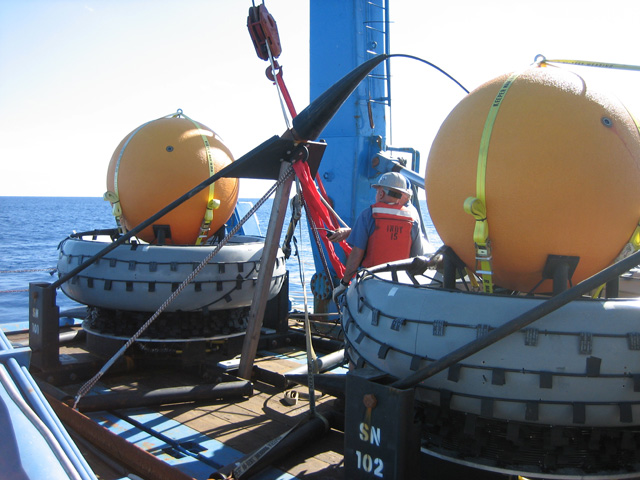18 April 2023–Ocean-based hydrophones in the Comprehensive Nuclear-Test-Ban Treaty Organization (CTBTO)’s seismoacoustic monitoring network could provide a better look at how ocean temperatures are changing over time, according to a presentation at the Seismological Society of America (SSA)’s 2023 Annual Meeting.
Finding new ways to monitor ocean temperatures is important for determining rates of warming, sea level rise and climate-related ocean circulation patterns as average global temperatures continue to rise, the researchers said.
Sound waves produced by earthquakes, called T waves, travel faster between their source and the hydrophones that detect them when the water in between the two points is warmer. As a result, researchers have been using T wave data to infer large-scale average ocean temperature changes, in a field called seismic ocean thermometry.
Land-based coastal stations sometimes have difficulty detecting these waves, which are created first in the solid earth by earthquakes and then converted to acoustic waves that travel through the water. To remedy this, Wenbo Wu of Woods Hole Oceanographic Institution and colleagues turned to CTBTO hydrophones to see if they could detect a clearer T wave signal.
Using two CTBTO hydrophones in the Indian Ocean, the researchers were able to capture T waves from earthquakes (magnitude 4 and smaller) that they then analyzed to track decadal warming and seasonal variations in ocean temperature, as well as detect energetic ocean circulation “swirls” called mesoscale eddies, Wu said.

Previous seismic ocean thermometry studies have relied on active source seismic signals—those produced by human-caused blasts or hammering to the ocean floor, he noted. “I think a major difference we are making here is that we are measuring natural earthquakes. And previously what scientists did was use active source.”
Hydrophones “are already used to monitor submarine earthquakes because they are very good at recording acoustic waves in the ocean,” Wu explained. But most land-based stations are not very good at recording T waves, “because these acoustic waves get decayed as they move into the continents.”
Hydrophones give the researchers a much better signal-to-noise ratio when it comes to detecting T waves from even small earthquakes, he said. “The data set from hydrophones is more than twice as large as from some land-based stations.”
With more T waves to analyze, researchers can better pinpoint the timing of ocean temperature changes, said Wu.
The technique could prove especially useful in regions where seismicity is naturally low, like the Atlantic Ocean, by boosting the overall number of useful earthquake sources, he suggested.
Wu and his colleagues also look at how T waves of different frequencies travel at different ocean depths. This phenomenon helps them monitor temperature changes over time within the water column, producing a “vertical slice tomography” look at temperature features within the ocean.
Wu said seismic ocean thermometry complements the other ways that scientists are tracking ocean temperature changes, including autonomous Argo floats and hydrographic surveys by ship. Each of these methods has its limitations—Most Argo floats measure temperatures only at shallow depths, for instance, and expensive surveys capture changes in only one part of the ocean for one specific time period.
The hydrophone-collected T wave data studied by Wu and colleagues could help expand the overall set of temperature changes collected across the oceans and offer a closer look at smaller, regional features as well.
